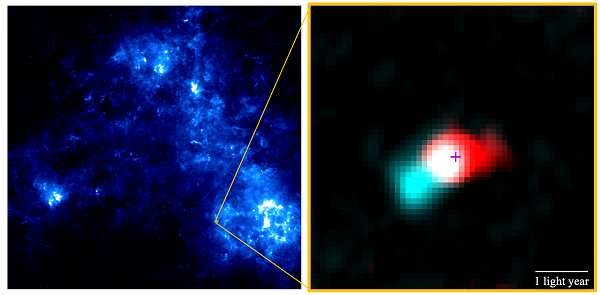Research News
Aug 30, 2022
ALMA discovers birth cry from a baby star in the Small Magellanic Cloud
The heavy elements in interstellar matter significantly impact the mechanism of star formation. In the early universe, the abundance of heavy elements was lower than in the present universe because there was not enough time for nucleosynthesis to produce heavy elements in stars. It has not been well understood how star formation in such an environment differs from present-day star formation.
An international team led by Professor Toshikazu Onishi, Osaka Metropolitan University, and Project Assistant Professor Kazuki Tokuda, Kyushu University/NAOJ, used the Atacama Large Millimeter/submillimeter Array (ALMA) to observe high-mass young stellar objects in the Small Magellanic Cloud.
The Small Magellanic Cloud is characterized by a low abundance of elements heavier than helium, similar to the galaxies 10 billion years ago. The target provides a detailed observational view thanks to the relatively close distance from the earth. In this study, researchers detected a bipolar gas stream flowing out of the “baby star” Y246 and determined that the molecular flow has a velocity of more than 54,000 km/h in both directions.
(Left): Wide-field far-infrared image of the Small Magellanic Cloud obtained with the Herschel Space Observatory. (Right): An image of the molecular outflow from the baby star Y246. Cyan and red colors show the blueshifted and redshifted gas observed in carbon monoxide emission. The cross indicates the position of the baby star.

In the present universe, growing “baby stars” are thought to have their rotational motion suppressed by this molecular outflow during gravitational contraction, accelerating the star growth. The discovery of the same phenomenon in the Small Magellanic Cloud suggests that this process of star formation has been common throughout the past 10 billion years. The team also expects this discovery to bring new perspectives to studying stars and planet formation.
Funding
This work was supported by JSPS Grants-in-Aid for Scientific Research (JP18H05440, JP19K14760, JP21H00049, JP21H00058, JP21H01145, and JP21K13962) and the ALMA Joint Scientific Research Project (2022-22B).
Paper Information
Journal: The Astrophysical Journal Letters
Title: The First Detection of a Protostellar CO Outflow in the Small Magellanic Cloud with ALMA
DOI: 10.3847/2041-8213/ac81c1
Author: Kazuki Tokuda, Sarolta Zahorecz, Yuri Kunitoshi, Kosuke Higashino, Kei E. I. Tanaka, Ayu Konishi, Taisei Suzuki, Naoya Kitano, Naoto Harada, Takashi Shimonishi, Naslim Neelamkodan, Yasuo Fukui, Akiko Kawamura, Toshikazu Onishi and Masahiro N. Machida
The Astrophysical Journal Letters
Contribution to SDGs

4: Quality Education
Contact
Graduate School of Science
Prof. Toshikazu ONISHI
E-mail: tonishi[at]omu.ac.jp
*Please change [at] to @.
SDGs
